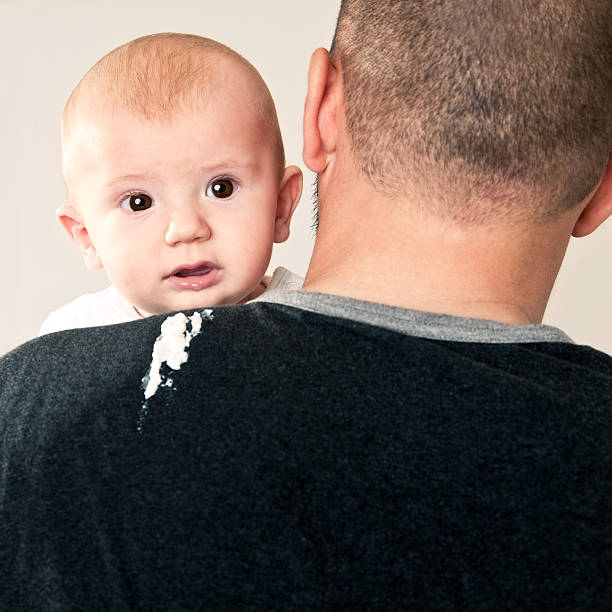8 Outstanding Questions on Acid Reflux in Babies
You might have heard the statement, “Acid reflux in babies is like heartburn.” But as a parent, this statement might not make any sense. In this post, we’ll cover:
What is acid reflux?
What causes acid reflux in babies?
What is the difference between GER and GERD?
What is Silent Reflux in Babies?
What are the symptoms of acid reflux in babies?
What are the risk factors of acid reflux in babies?
What are the natural remedies for acid reflux in babies?
How do you treat acid reflux in babies?
We’re sharing everything you need to know about acid reflux in babies immediately.
What is Acid Reflux?

According to the Academy of Nutrition and Dietetics, acid reflux, clinically known as gastroesophageal reflux (GER), occurs when a baby spits up stomach content. In short, your baby spits up food or other fluids that they take.
It is common for babies to have acid reflux several times a day. After all, they are eating or suckling, right?
The Cleveland Clinic states that 50% of infants show reflux by three months. The publication further states that 66% of all infants aged 4 months experience reflux. However, the number of babies experiencing reflux decreases significantly to 14% by the seventh month.
What Causes Acid Reflux In Babies?
Reflux in babies mainly occurs due to their underdeveloped gastrointestinal system. Simply put, the muscular valve connecting babies’ stomachs and esophagus is underdeveloped. When the baby ingests food or fluids, this valve might remain open. Any slight movement of the food or acid in the stomach makes the food come out involuntarily.
Reflux is very common in babies and should not be a cause for alarm to you.
What Is the Difference Between GER and GERD?

As you seek knowledge on reflux in your baby, you will likely come across two acronyms: GER and GERD. What are they, and how do they relate to reflux?
Gastroesophageal reflux (GER): GER is what we have just described, a condition characterized by spitting stomach contents. Toddlers and bigger people refer to GER as heartburn or indigestion. Unlike babies who spit up, adults belch. It is harmless and clears after a short period.
Gastroesophageal reflux disease (GERD): When the acid reflux becomes chronic, or in simple terms, fails to clear, it is referred to as GERD. If left untreated, GERD might completely affect your baby’s life or even destroy its esophagus.
“Can I tell the difference between GER and GERD?” is one of the questions that is asked the most. Well, the answer is it isn’t! If your baby keeps having numerous refluxes several times a day and their appetite goes down, take them to a pediatrician immediately. Such symptoms could be a sign of GERD in waiting.
What is Silent Reflux in Babies?

What does silent reflux in babies mean? You might have come across this word for the first time.
Silent reflux is when the stomach contents get stuck in the baby’s esophagus and don’t come out at all.
As a result, the baby swallows the contents again. Bigger toddlers and even adults experience silent reflux.
When the stomach contents of food, fluids, and acid get to the baby’s esophagus, they leave an irritating effect. You might only see your baby crying, coughing, or having a hoarse voice. If you suspect that your baby has silent reflux, talk to the pediatrician for further advice and diagnosis.
What Are the Symptoms of Acid Reflux in Babies?
We have already stated that reflux causes babies to spit up stomach contents. Are there other symptoms that babies with acid reflex might manifest? Of course, there are, and they might help you differentiate between GER and GERD.
Symptoms of GER In Babies
Babies with GER are likely to have these two symptoms:
- Spitting or vomiting after feeding.
- Occasional spitting, which might interfere with feeding.
In most cases, GER kicks in between 2 to 3 weeks after delivery and peaks at 4 to 5 months before reducing significantly and finally disappearing.
Symptoms of GERD In Babies

As we mentioned earlier, GER can get on steroids and become GERD. If your baby develops one or more of these symptoms, they could be having GERD:
- Forceful expulsion of food immediately after feeding.
- Wheezing
- Stunted growth and limited or no weight gain.
- Irritability causes the baby to arch its back during feedings.
- Difficulty in swallowing.
- Refusal to bottle feed.
- Noisy breathing and hoarse voice.
- Vomiting blood.
Don’t sit back and watch as your baby encounters these symptoms linked to GERD. Seek medical help as soon as possible.
What Are the Risk Factors of Acid Reflux in Babies?

We have already mentioned that GER, the most common type of acid reflux in babies, can affect any baby. While this is true, certain factors increase babies’ risk of getting GER and GERD. These factors include:
- Lung conditions such as cystic fibroids.
- Premature birth.
- Previous surgery on the esophagus.
- Orthopedic impairment such as cerebral palsy.
What Are the Natural Remedies for Acid Reflux in Babies?

GER, the most common acid reflux in babies, is not harmful. As a parent, you can use natural remedies to suppress the intensity of acid reflux. The natural remedies for acid reflux in babies include:
1. Keeping Your Baby in Upright Position
After feeding your baby, keep them at a 90-degree angle for about 20 minutes. Keeping your baby in an upright position after feeding reduces the risk of the stomach contents from getting back through the esophagus.
2. Small-Frequent Feedings

A baby’s stomach is tiny and cannot accommodate a lot of food. Despite the small size, a baby’s digestion rate is high.
As a parent, you should keep the feeding quantities as small as possible, but don’t starve them. This feeding strategy reduces the risk of overfeeding your baby, which I tackled in this article.
Your baby might not be comfortable with this feeding arrangement, and at first, they might get cranky and fussy. However, with patience, the baby will adjust to the feeding and stop having extreme refluxes.
3. Frequent Burping
Do you remember the previous article on how to burp your baby? If you missed it, here it is.
Burping your baby frequently expels any air that might be trapped inside the baby’s tummy or even the esophagus.
Besides, burping a baby is a sure way to create more space for milk and other fluids in their tummy.
According to Medline Plus, every time you burp a baby, the acid levels in their tummy go down. Consequently, the reflux symptoms in the baby reduce significantly.
4. Breastfeeding and Changing Formula
If you have not been breastfeeding your baby for personal reasons rather than medical, consider changing the decision. Breast milk contains incredible benefits, which might reduce reflux symptoms.
If your baby is using formula exclusively, talk to your pediatrician. Your pediatrician could suggest a different brand since the formula could trigger reflux symptoms. The pediatrician could suggest using lactose-free or hypoallergic options, which are considered safer.
5. Avoid Smoking
Did you know that smoking relaxes the lower esophageal sphincter valve, responsible for keeping food in the tummy? As a breastfeeding mom, avoid smoking since it increases the risk of your baby developing GER.
6. Thicken Your Baby’s Milk

Whether you feed your baby with expressed milk or formula, it is recommended that you thicken it. “How do I thicken milk for my baby?” You might ask.
Well, RACGP recommends using feed thickeners since they are effective in reducing acid reflux.
Feed thickeners ease the digestion process and reduce the GER and GERD symptoms.
Additionally, thickened milk or formula makes the baby full easily and suppresses the risk of overfeeding and spitting.
The most common feed thickener that parents use is rice cereal. Despite its popularity, rice cereal feed thickeners contain excess calories and are hard to swallow.
- Loosen Diapers and Clothing
Using tight clothes or diapers can be detrimental to a baby’s health. The two add pressure to the baby’s soft and delicate tummy, raising acid and content levels significantly, leading to GER symptoms.
To reduce GER symptoms, leave some space for breathing when changing clothes or putting a diaper on a baby.
8. Check Nipple Size

If you bottle-feed a baby, check the nipple size to ascertain that it is not too big or small.
Extremely big or small nipples cause excess air to be trapped inside the bottle, making the baby ingest it. The more air the baby ingests, the higher the risk of acid reflux.
9. Reduce Playtime After Feeding
Avoid jostling your baby too much after feeding them.
Let the food settle first in the stomach. If you don’t, you will have to deal with clothes full of spit-ups.
How Do You Treat Acid Reflux in Babies?

As we mentioned at the start of this post, GER in babies goes away after a certain period.
But what happens when the acid flux in babies gets worse?
Doctors recommend using acid reducers to treat acid reflux in babies. The most common acid reducer is ranitidine, commonly known as Zantac.
In severe reflux cases, your doctor may recommend other medications such as omeprazole (Prilosec) and lansoprazole (Prevacid).
The effectiveness of these acid reducers depends on the reflux levels and stage of the baby.
Which Questions Should I Ask My Doctor?
As a parent, you are entitled to know more about your baby’s acid reflux. These are some of the questions to ask the doctor:
- What could be the leading cause of reflux in my baby?
- How can I contain the acid reflux symptoms?
- Will the symptoms clear on their own, or my baby needs medication?
- Which is the best treatment for my baby?
- What are the side effects of the treatment options?